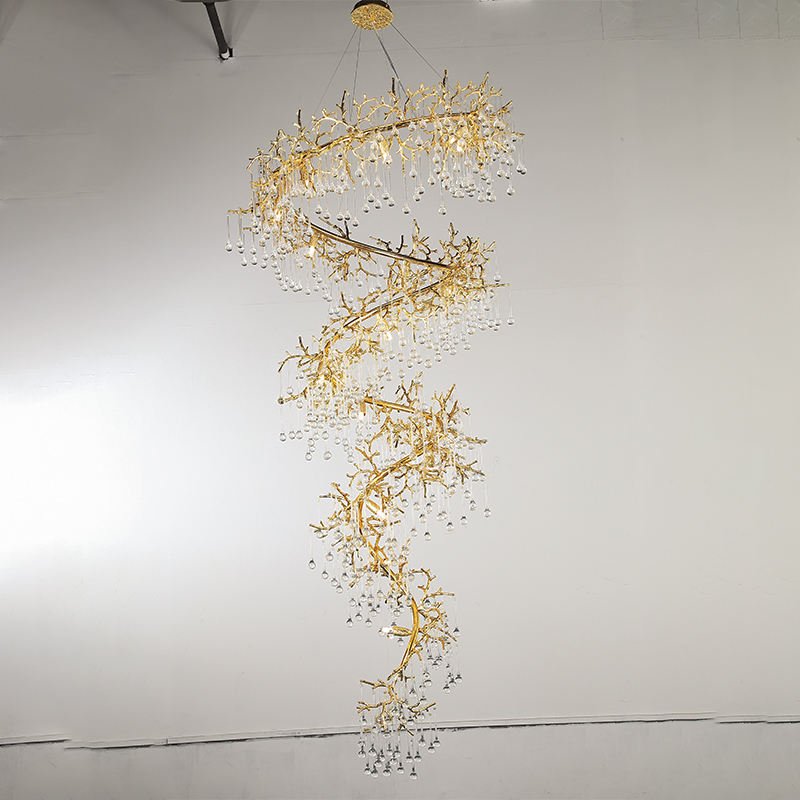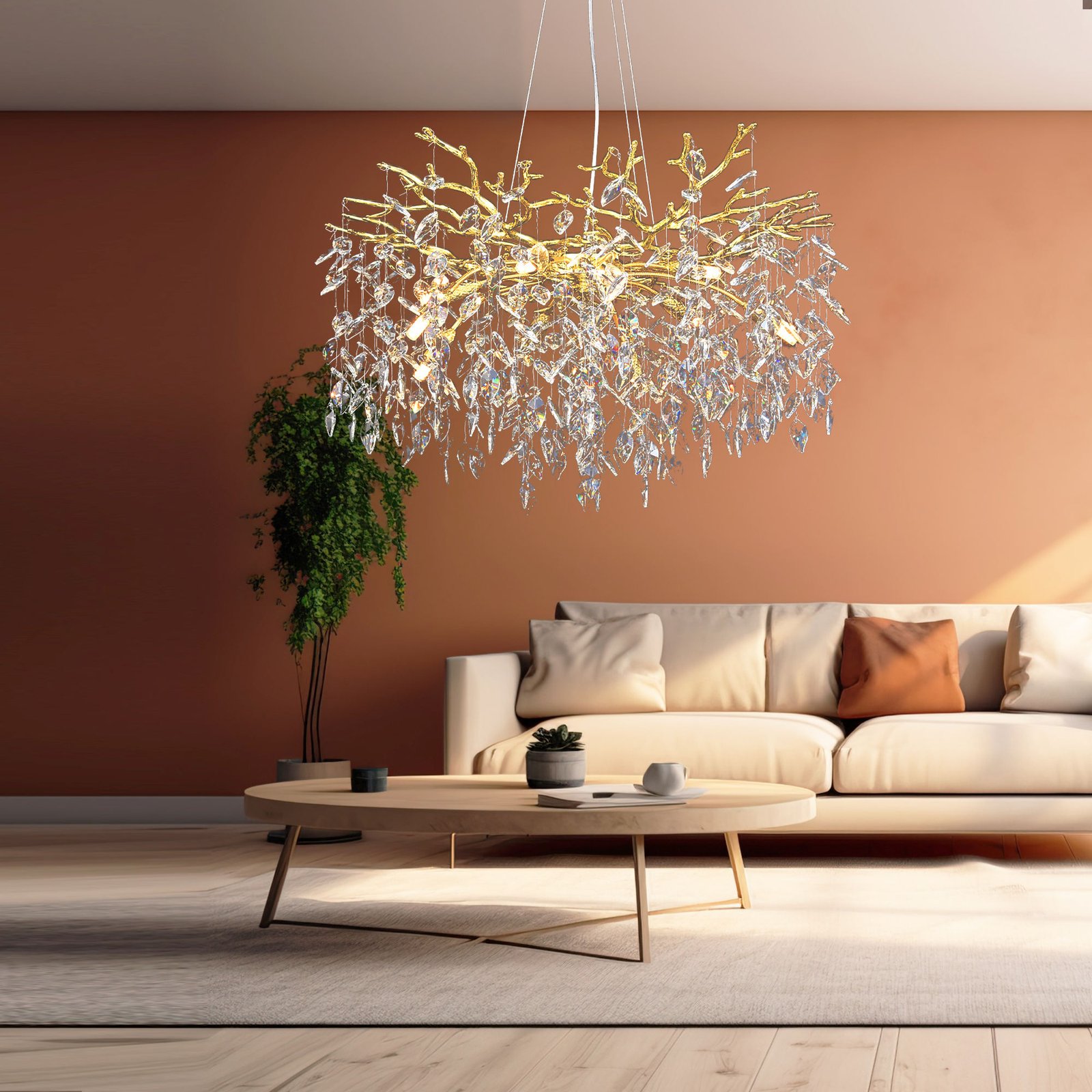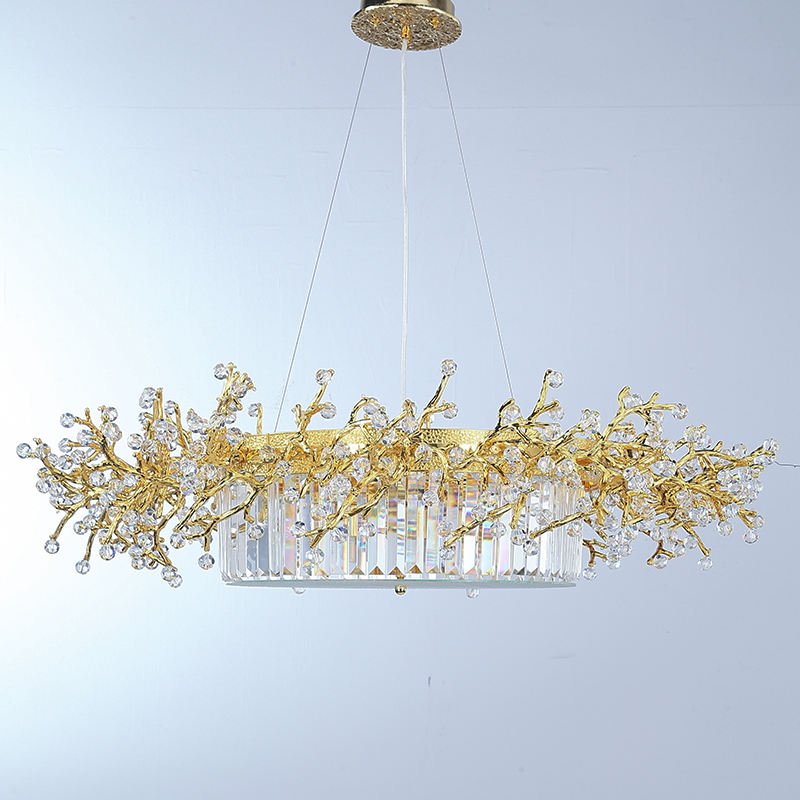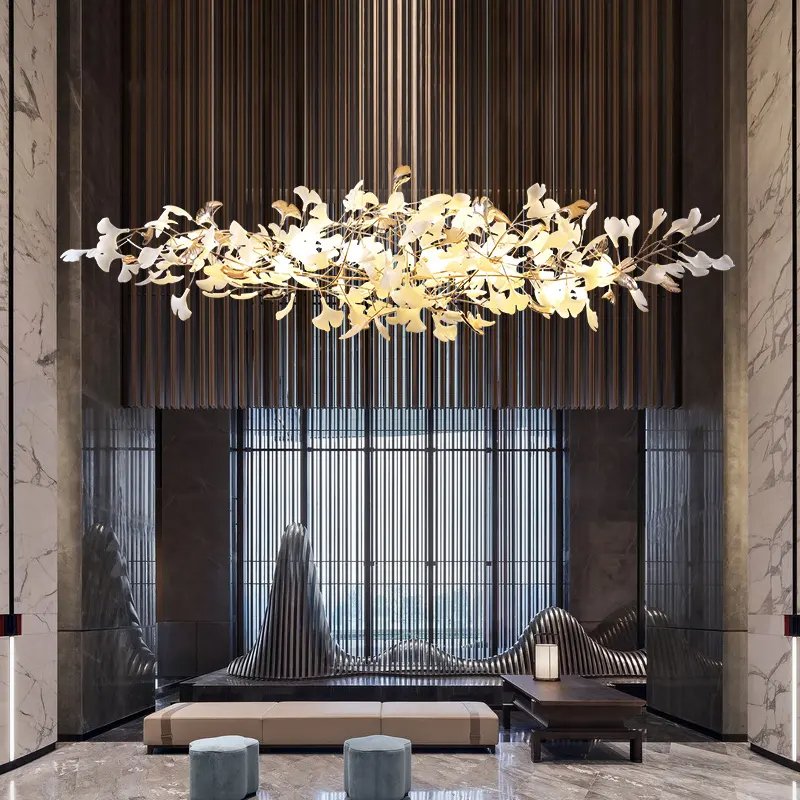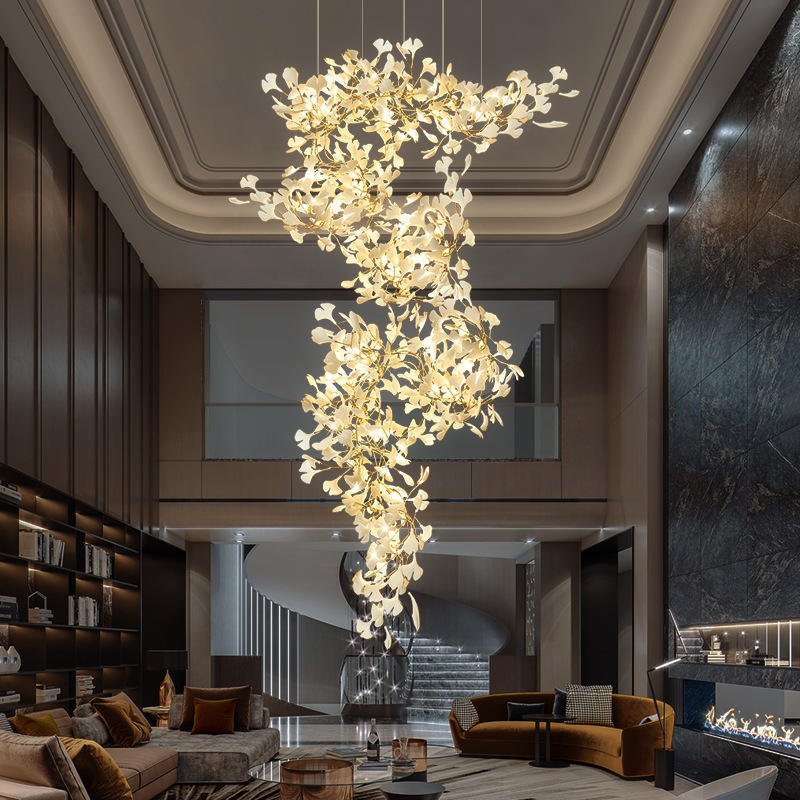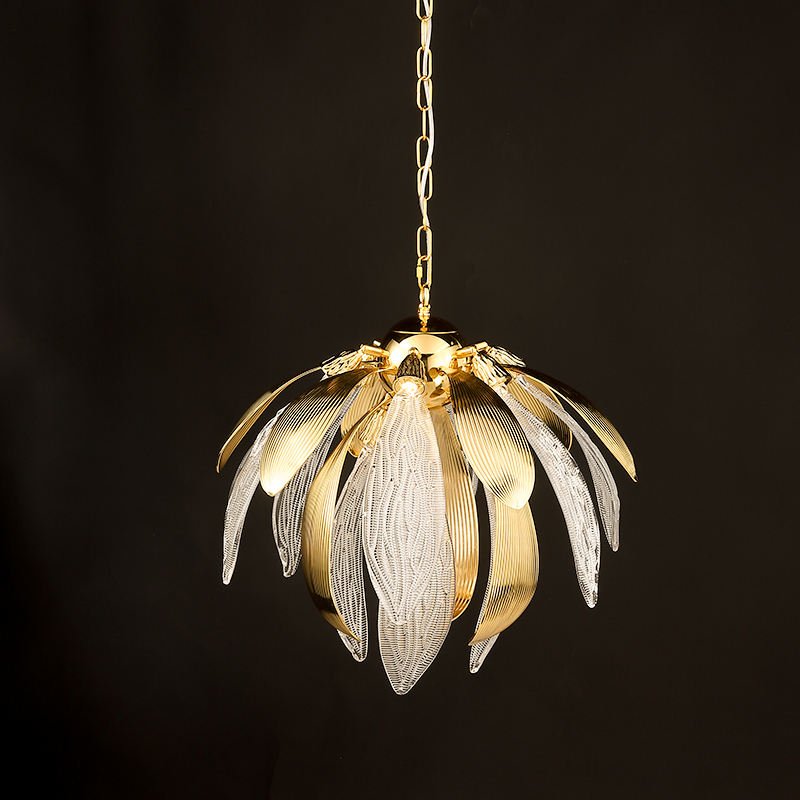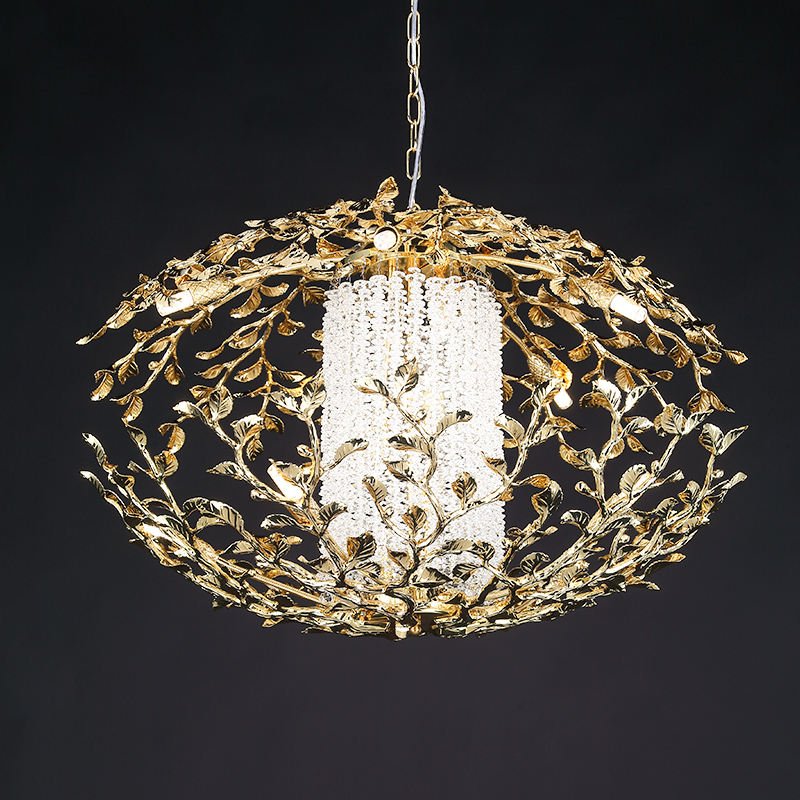Key Takeaways
- Branch chandeliers blend nature-inspired designs with modern aesthetics.
- They serve as striking focal points in various interior settings like dining rooms, living areas, and entryways.
- Styles range from minimalist metal branches to elaborate designs featuring crystals or floral elements.
- Consider size, scale, ceiling height, and existing decor when choosing a branch chandelier.
- Materials often include metals (gold, brass, black) and embellishments like crystal or glass.
- Proper installation and bulb choice are crucial for safety and desired lighting effects.
- While DIY options exist, professionally crafted fixtures generally offer better quality and safety assurance.
What Makes Branch Chandeliers So Darn Appealing Anyway?
So, what’s the big deal with these branch chandeliers? Why’s everyone suddenly loving them? Well, it’s kinda simple when you think about it. They got this unique look, right? It’s like bringing a bit of the outdoors inside, but in a really stylish, modern way. Not like dragging an actual tree branch in, obviously. More like an artist looked at a tree and thought, “How can I make this into light?” The result is something that feels organic and natural, but also sophisticated. It hits that sweet spot between wanting a connection to nature and needing your home to look sharp and contemporary. They ain’t just lights; they’re more like sculptures that happen to light up a room. You walk into a space with a good branch chandelier, and your eyes just go straight to it. It’s a statement, tells you something about the person who lives there.
Another thing is their versatility. You might think ‘branch’ means rustic, cabin-style vibes, but that’s not the whole story. Not at all. You can find designs that fit perfectly in a super minimalist apartment, others that look amazing in a more traditional home thats been updated, and yeah, some that do lean into that modern farmhouse thing. The materials make a big difference – sleek black metal branches feel totally different to warm gold ones, and adding crystals changes the game again. I’ve seen these things work wonders in dining rooms, hanging low over a table, or making a grand entrance in a double-height foyer. They just adapt. It’s this mix of art, nature, and light that makes ’em so popular right now. People are lookin’ for ways to make their homes feel special and personal, and these fixtures definately deliver on that. Exploring the beauty and variety of branch chandeliers really shows you how many directions designers take this concept. It’s not just one look; it’s a whole category of interesting lighting.
The Different Flavors: Exploring Branch Chandelier Styles
Alright, so “branch chandelier” ain’t just one thing. There’s loads of different styles out there, kinda like different types of trees in a forest, you know? You got your linear branched chandeliers, which are great over long dining tables or kitchen islands. They stretch out horizontally, often with lights pointing up, down, or both, mimicking a branch reaching across a space. Then there are the more sprawling, multi-directional ones that look like a burst of twigs, perfect for filling vertical space in a foyer or adding drama to a living room corner. Some designers go really abstract, where the ‘branch’ idea is more suggested than literal – maybe just angled arms connected in an organic way. Others stick closer to nature, replicating the twists and turns of real wood.
Materials play a huge part in the style, like I mentioned.
- Metals: Gold, brass, bronze bring warmth and a touch of luxe. Black or dark bronze offers a more modern, industrial, or even slightly moody feel. Polished chrome or nickel can look very sleek and contemporary.
- Crystal/Glass: Adding crystals, whether they’re simple drops, elaborate icicles, or shaped like leaves, brings sparkle and refracts light beautifully. This pushes the chandelier towards a more glamorous or transitional style. Some use frosted or coloured glass for a softer effect.
- Wood: Less common in the truly modern styles, but some incorporate wood elements for a more rustic or Scandinavian vibe. Usually combined with metal.
And then you got the details. Some branches are smooth and clean, others have textures that mimic bark. The lights themselves vary too – bare bulbs for an Edison-style look, integrated LEDs for a seamless modern feel, or shades made of glass, fabric, or even metal shapes like leaves or flowers. Thinking about the different types of branch chandeliers helps you narrow down what might work in your own space. Are you after subtle nature vibes or full-on golden forest glamour? Do you need focused light downwards or ambient light all around? It’s worth looking at lots of pictures, maybe even checking out sites like Pinterest for modern branch chandeliers to get a feel for the massive variety available. It’s not just about picking a branch chandelier, it’s about picking the right branch chandelier for your room’s personality.
Modern Takes: Tree Branch Designs for Today’s Homes
When we talk about modern tree branch chandelier designs, we’re often looking at interpretations that are less literal, more artistic. It’s not always about making it look exactly like a specific tree branch found in the woods. Modern design often plays with form, material, and light in fresh ways. You might see branches that are incredibly sleek and geometric, barely hinting at their natural inspiration. Or perhaps designs that exaggerate certain features – super elongated arms, clusters of lights that look like futuristic buds, or finishes in unexpected colours. The Ethereal Icicle Chandelier, for example, takes the branch concept and combines it with delicate, sparkling elements that feel both natural (like ice on a winter branch) and highly sophisticated. It’s this blend that feels really current.
These modern designs are particularly good for unique spaces. Got a room with an awkward corner? A sculptural branch chandelier can turn it into a feature. High ceilings begging for attention? A multi-tiered or vertically oriented branch design can draw the eye upwards and fill the volume beautifully. Even in simpler, standard-height rooms, a well-chosen modern branch fixture can add a layer of complexity and interest that plain lighting just can’t match. Think about placing one in an entryway – it sets the tone for the whole house right away. Or in a living room, where it can be a conversation starter. Dining rooms are classic spots, of course, creating ambiance over the table. The key is matching the fixture’s scale and style to the room’s function and existing look. A huge, dramatic chandelier might overwhelm a small dining nook, while a tiny one would get lost in a grand living area. It’s about balance.
What I really appreciate as someone who looks at lighting all day is how designers are using materials in these modern pieces. Polished metals reflecting light, matte finishes absorbing it, the interplay of crystal or glass with the solid ‘branch’ structure… it’s all carefully considered. Some designs focus purely on the form, with minimal embellishment, letting the silhouette do the talking. Others, like the Luxe Gilded Leaf Cluster, are all about intricate detail and rich texture. They feel organic but also incredibly crafted. It’s this thoughtful approach to design that makes modern branch chandeliers feel so special and allows them to integrate seamlessly into sophisticated interiors, adding character without feeling out of place. They manage to be both statement pieces and harmonious parts of the overall design scheme.
Getting it Right: Placing Branch Chandeliers in Your Home
Okay, so you’ve decided you like the idea of a branch chandelier. Cool. Now, how do you actually make it work in your house? Choosing and placing it right is pretty important, you don’t want it looking weird or bumping your head on it. The ultimate guide to choosing the perfect branch chandelier has some solid advice, but here’s my take. First up, size and scale. This is probably the biggest thing people get wrong. A chandelier thats too small looks kinda sad and lost. Too big, and it just dominates the room, makes it feel cramped. A general rule for dining rooms is to pick a fixture that’s about 1/2 to 3/4 the width of your table. For a room like a living room or bedroom, add the room’s length and width in feet, and that number (in inches) is a decent starting point for the chandelier’s diameter. But rules are made to be bent, right? Sometimes a slightly oversized chandelier can look amazing if the ceilings are high or the style is intentionally bold. Use your eye, maybe even make a cardboard cutout to test the size visually.
Placement is key too. Over a dining table, you want the bottom of the fixture to hang about 30-36 inches above the tabletop. This keeps it out of sightlines when you’re seated but close enough to feel connected to the table setting. In a foyer or living room with standard 8-foot ceilings, you need at least 7 feet of clearance underneath so people don’t hit their heads. With higher ceilings, you can hang it lower to fill the space better, but still keep walkways clear. Think about the main viewing angles. Where will you see the chandelier from most often? Position it so its best features are visible from there. Also consider how the branches spread – will they interfere with opening cabinets or doors if placed too close? Seems obvious, but worth double checking.
Matching it with your decor is the fun part. If your style is very clean and modern, a sleek, perhaps black or chrome, minimalist branch design would fit right in. Got a more glam space? Go for gold or brass, maybe with crystal elements like that Lotus Blossom one above. Bohemian or eclectic? Something with a more organic, less symmetrical shape could be perfect. Don’t feel like it has to perfectly match everything though. Sometimes the contrast is what makes it interesting. A modern branch chandelier can actually look really cool in a more traditional room, updating the whole vibe. The lighting effects are also crucial; consider the type of bulbs (warm vs cool light) and whether you need dimmers to control the mood. Getting the modern homes lighting effects right is just as important as the fixture itself.
Sparkle and Bloom: Crystal and Floral Details
Let’s talk about the bling. Some of the most stunning branch chandeliers aren’t just about the branches themselves; they incorporate other elements, specially crystals and floral shapes. This adds another layer of detail and often, a touch of luxury or whimsy. Think about crystals – they catch the light, refract it, create little rainbows around the room. It adds sparkle and movement. You see designs with simple crystal drops, like dew on a branch, or more elaborate icicle shapes that cascade down. The Modern Golden Branch Crystal Raindrop Dining Chandelier is a perfect example, mixing the organic branch form with elegant, light-catching drops. These work particularly well in dining rooms or living areas where you want a bit of glamour. The Branch Crystal Chandelier Collection shows just how varied these can be.
Then there are the floral elements. Instead of just bare branches, some designs incorporate leaves, buds, or even fully bloomed flowers, often made from metal or glass. Look at the Elegant Gold Lotus Flower Pendant Light or the Luxe Gold Lotus Blossom Chandelier – the branch structure is still there, but it supports these beautiful, stylized flowers that contain or surround the light sources. This approach softens the look, makes it feel a bit more romantic or decorative. Designs like the Golden Leaf Crystal Nest Chandelier combine both – branches, leaves, and crystals, creating a really rich, textured effect. It’s like a little piece of enchanted forest hanging from your ceiling.
The key with these embellished designs is balance. Too much crystal or too many flowers, and you can lose the elegance of the branch form itself. The best designs use these elements thoughtfully, enhancing the structure rather than overwhelming it. The choice between crystal, floral, or a combination often comes down to personal taste and the room’s overall style. Crystals tend to feel more formal and glamorous, while floral elements can lean towards romantic, traditional, or even art nouveau depending on the execution. Both add significant visual interest and play with light in beautiful ways, turning the chandelier from just a light source into a real jewel for the room. It’s about finding that piece where the branches provide the structure and the embellishments add the magic touch.
The DIY Question: Should You Make Your Own?
Now, you see all these cool branch chandeliers, and maybe the crafty side of your brain starts thinking, “Hey, could I make one myself?” It’s tempting, right? Especially with the whole DIY craze. There are definately people who try it, using actual branches sometimes, or assembling parts. And you can find guides online, like a potential DIY step-by-step guide or ideas for creative upcycling. The appeal is obvious: potentially save money, get exactly the look you want, and have the satisfaction of making something unique. You could forage for the perfect branch, clean it up, figure out how to wire it… sounds kinda fun, maybe?
But, hold on a sec. As someone who deals with lighting professionally, I gotta wave a little caution flag here. Working with electricity isn’t like knitting a scarf. There are real risks if you don’t know exactly what you’re doing. Messing up the wiring can lead to shorts, fires, or worse. That’s why understanding DIY safety tips for lighting is absolutely critical if you even think about attempting this. Beyond safety, there are other hurdles. Getting the materials right – finding branches that are strong enough, properly dried, and treated to prevent pests or decay. Then there’s the challenge of making it look polished and professional, not just… well, like a branch with some wires stuck to it. Avoiding common DIY mistakes takes knowledge and skill. Weight distribution, proper mounting hardware, choosing the right bulb holders and wire gauges – it’s more complex than it looks.
Honestly, while the idea of a DIY branch chandelier has its romantic appeal, for most people, it’s probably more hassle and risk than it’s worth. Professionally manufactured chandeliers have been designed by experts, tested for safety (look for UL or ETL listings!), and built with appropriate materials to last. You get a level of finish and quality assurance that’s really hard to replicate at home unless you have significant electrical and crafting skills. Plus, think about the time involved. Foraging, prepping, designing, wiring, troubleshooting… it adds up. Sometimes, investing in a well-made fixture from a reputable source is just the smarter, safer, and ultimately more satisfying option. You get the beautiful look without the potential headaches (or hazards). So, while I admire the DIY spirit, for complex electrical items like chandeliers, proceeding with extreme caution (or just buying one) is usually the best advice.
Finding Your Perfect Branch: Where to Look
Okay, decided DIY isn’t for you? Smart move, probably. So, where do you find these stylish branch chandeliers we’ve been talking about? Good news is, they’ve become popular enough that you have quite a few options, ranging in style and price. Specialty lighting stores, both online and brick-and-mortar, are a great place to start. They often curate collections from various designers and manufacturers, giving you a good overview of what’s available. Websites dedicated to lighting, like Seu’s Lighting Branch Chandelier Collection, often categorize them nicely, making browsing easier. You can find everything from minimalist metal designs to elaborate crystal-dripping creations.
Large online home goods retailers are another major source. Think places like Wayfair – their keyword search page probably lists dozens, if not hundreds, of branch chandeliers under various search terms (“branch chandelier,” “tree chandelier,” “twig chandelier”). The sheer volume can be overwhelming, but the filters for price, style, finish, and size are your friends here. Just be sure to read reviews and check dimensions carefully. Sometimes photos can be a bit deceiving online. Don’t forget about platforms focused on curated or unique designs too. Pinterest, as mentioned before (Modern Branch Chandeliers), is fantastic for inspiration and often links directly to retailers or designer pages. Sites specializing in specific styles, like those focusing on crystal fixtures (Branch Crystal Chandelier Collection by Lyfairs), can help if you know exactly what kind of embellishment you’re after.
When you’re shopping, keep a few things in mind:
- Budget: Branch chandeliers can range from a couple hundred dollars to many thousands for high-end designer pieces. Set a realistic budget beforehand.
- Style: Have a clear idea of the aesthetic you want – modern, rustic, glam, minimalist?
- Size: Remember those measurements! Check diameter, height, and hanging length against your room’s dimensions.
- Quality: Look for sturdy construction, good quality materials, and safety certifications (UL/ETL listed). Read product descriptions and reviews.
- Installation: Factor in potential installation costs if you’re not comfortable doing it yourself (which, for chandeliers, is often wise).
Taking some time to browse different sources, compare options, and maybe even read articles showcasing specific designs, like this one on 10 Stunning Tree Branch Chandeliers, can help you feel confident in your final choice. Don’t rush it; the right chandelier can be a long-term investment in your home’s style.
The Expert View: Why We Love Branch Chandeliers in Modern Spaces
Alright, let me put my “lighting geek” hat on for a second. Why do designers and lighting experts like myself often recommend branch chandeliers for modern homes? There are a few key reasons why these fixtures just work so well right now. Firstly, they nail that connection to nature that so many people are craving in their interiors. In a world full of screens and manufactured materials, having something that evokes the organic lines of a tree branch feels grounding and calming. It’s biophilic design – the idea that connecting with nature indoors is good for us – made elegant. But crucially, they do it without looking overly rustic or out of place in a contemporary setting. They translate nature into a modern design language.
Secondly, they are fantastic sculptural elements. A well-designed branch chandelier is more than just a light source; it’s functional art. It adds visual interest and complexity to a room, often becoming a natural focal point. I remember working on a project with a large, open-plan living/dining area that felt a bit soulless. We added a large, multi-armed branch chandelier in a warm brass finish over the dining zone, and honestly, it transformed the entire space. It defined the dining area, added warmth and texture, and gave the room the ‘wow’ factor it was missing. They have a unique ability to be both eye-catching and blend harmoniously, depending on the specific design and finish. Exploring the beauty and variety of branch chandeliers really underscores this versatility.
Finally, they offer interesting lighting possibilities. The scattered light sources on different arms can create a beautiful ambient glow, washing walls and ceilings with soft light. Depending on the bulb type and direction, they can also provide functional downlighting. Many are dimmer-compatible, allowing you to adjust the mood from bright and functional to soft and atmospheric. This flexibility is key in modern living, where rooms often serve multiple purposes. The way light interacts with the branch forms themselves – creating shadows and highlights – adds another layer of visual depth. So, yeah, we love them because they tick a lot of boxes: nature-inspired aesthetics, artistic sculptural quality, and versatile, beautiful illumination. They just bring a special kind of character and style to modern interiors that’s hard to beat.
Frequently Asked Questions (FAQs)
Q1: How do I figure out the right size branch chandelier for my room?
A: A good starting point is to add the room’s length and width in feet. That number, in inches, can be a rough guide for the chandelier’s diameter. For dining rooms, aim for a diameter that’s about 1/2 to 3/4 the width of your table. Also consider ceiling height – taller ceilings can handle larger or longer fixtures. Always check clearance requirements (usually 7 feet minimum over walkways).
Q2: What kind of light bulbs do branch chandeliers typically use?
A: It varies widely! Some use standard E12 (candelabra) or E26 (medium) base bulbs, allowing you to choose LEDs, incandescents (though less common now), or vintage-style Edison bulbs. Others have integrated LED modules, which are energy-efficient and long-lasting but may not be replaceable. Check the product specs carefully before buying.
Q3: Are branch chandeliers hard to install?
A: They can be trickier than standard flush-mount lights, especially larger or heavier ones. They often require careful assembly of the branches and secure mounting to a ceiling electrical box rated for the fixture’s weight. Due to the electrical work and weight, it’s generally recommended to hire a qualified electrician for installation unless you have significant experience. Remember those DIY safety tips!
Q4: How do I clean a branch chandelier, especially one with crystals?
A: Turn off the power first! For the branches (metal or wood), use a microfiber duster or a slightly damp cloth. Avoid harsh chemicals. For crystals, you can often use a specialized crystal cleaner spray and a lint-free cloth, or carefully wipe them with a cloth slightly dampened with distilled water and a drop of vinegar or isopropyl alcohol. Work carefully around electrical components. Regular dusting prevents major buildup.
Q5: Are branch chandeliers just a trend, or will they stay in style?
A: While their popularity has certainly surged, the core concept – nature-inspired design – has timeless appeal. The specific styles might evolve (e.g., finishes, level of abstraction), but the idea of bringing organic forms into lighting is likely to endure. Choosing a classic finish like brass, black, or a simple metallic, and a well-proportioned design, will give your chandelier greater longevity than something overly trendy.


